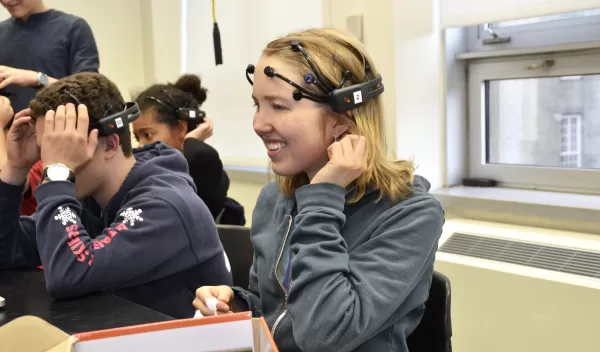
Neuroscience outside the laboratory
Social dynamics, or the ways humans interact in groups and influence each other's behavior, play a major role in how people learn. But scientists studying learning using traditional laboratory methods often strip away these important dynamics when seeking to answer specific questions about brain function.
A study just published in Current Biology and funded by the National Science Foundation (NSF) presents a promising method to assess brain activity in an environment where social dynamics can also be measured and assessed: the classroom.
Over the course of a semester, a team of neuroscientists monitored high school students and teachers who wore portable electroencephalogram (EEG) headsets during class lessons. The students and teachers participated in lectures and discussions, and watched instructional videos.
Using this new method, the scientists found that synchronized brain activity among students in a classroom was a good predictor of their focus, social connectedness and overall classroom engagement.
"Human brains have evolved in a social context -- that is, our brains are designed to learn through complex social interactions," says lead author Suzanne Dikker, a research scientist at New York University's department of psychology and Utrecht University in the Netherlands. "Yet much learning and education research has focused on individual experience.
Using portable EEG technology and methods of analysis developed by University of Florida scientists Lu Wan and Mingzhou Ding, the research team was able "to ask important questions about learning in real-time and in a social environment, in this case, an actual high school classroom," Dikker said. NSF has also provided support for Ding's work.
The new study measured paired-student interactions, interactions across the group as a whole and interactions between individual students and the rest of the group. The degree to which students' brainwaves aligned predicted both their levels of engagement in the classroom activity and their social connectedness.
"These findings have implications for education researchers who might want to know what teaching techniques increase engagement and for basic neuroscientists who want to unpack the neural, psychological and social processes underlying learning," says senior author David Poeppel, professor of psychology at New York University and director of the Max Planck Institute for Empirical Aesthetics in Frankfurt.
This work is part of the NSF BRAIN Initiative, a portfolio of supported research that is developing a better understanding of the many complex aspects of brain function through targeted, cross-disciplinary investments in research, technology and workforce development. More information on NSF investments in fundamental brain research are available at the NSF BRAIN Initiative website.
